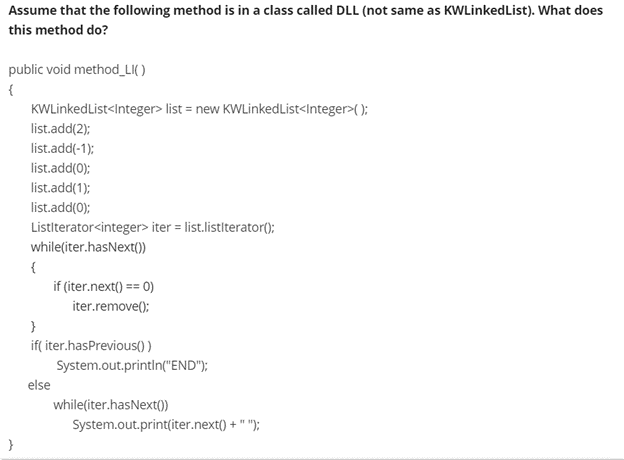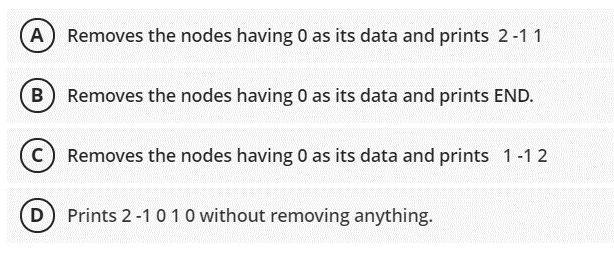Assume that the following method is in a class called DLL (not same as KWLinkedList). What does this method do? public void method_LI(). KWLinkedList list = new KWLinkedList( ); list.add(2); list.add(-1); list.add(0); list.add(1); list.add(0); Listiterator iter = list.listlterator(); while(iter.hasNext() if (iter.next() == 0) iter.remove(); if( iter.hasPrevious() ) System.out.printIn("END"); else while(iter.hasNext()) System.out.print(iter.next() + " ");
Assume that the following method is in a class called DLL (not same as KWLinkedList). What does this method do? public void method_LI(). KWLinkedList list = new KWLinkedList( ); list.add(2); list.add(-1); list.add(0); list.add(1); list.add(0); Listiterator iter = list.listlterator(); while(iter.hasNext() if (iter.next() == 0) iter.remove(); if( iter.hasPrevious() ) System.out.printIn("END"); else while(iter.hasNext()) System.out.print(iter.next() + " ");
Database System Concepts
7th Edition
ISBN:9780078022159
Author:Abraham Silberschatz Professor, Henry F. Korth, S. Sudarshan
Publisher:Abraham Silberschatz Professor, Henry F. Korth, S. Sudarshan
Chapter1: Introduction
Section: Chapter Questions
Problem 1PE
Related questions
Question

Transcribed Image Text:Assume that the following method is in a class called DLL (not same as KWLinkedList). What does
this method do?
public void method_LI( )
{
KWLinkedList<Integer> list = new KWLinkedList<Integer>( );
list.add(2);
list.add(-1);
list.add(0);
list.add(1);
list.add(0);
Listlterator<integer> iter = list.listlterator();
while(iter.hasNext())
{
if (iter.next() == 0)
iter.remove();
if( iter.hasPrevious() )
System.out.println("END");
else
while(iter.hasNext()
System.out.print(iter.next() + " ");
}

Transcribed Image Text:A Removes the nodes having 0 as its data and prints 2-11
B Removes the nodes having 0 as its data and prints END.
C Removes the nodes having 0 as its data and prints 1-12
Prints 2-1 0 10 without removing anything.
Expert Solution
This question has been solved!
Explore an expertly crafted, step-by-step solution for a thorough understanding of key concepts.
Step by step
Solved in 2 steps

Knowledge Booster
Learn more about
Need a deep-dive on the concept behind this application? Look no further. Learn more about this topic, computer-science and related others by exploring similar questions and additional content below.Recommended textbooks for you

Database System Concepts
Computer Science
ISBN:
9780078022159
Author:
Abraham Silberschatz Professor, Henry F. Korth, S. Sudarshan
Publisher:
McGraw-Hill Education

Starting Out with Python (4th Edition)
Computer Science
ISBN:
9780134444321
Author:
Tony Gaddis
Publisher:
PEARSON

Digital Fundamentals (11th Edition)
Computer Science
ISBN:
9780132737968
Author:
Thomas L. Floyd
Publisher:
PEARSON

Database System Concepts
Computer Science
ISBN:
9780078022159
Author:
Abraham Silberschatz Professor, Henry F. Korth, S. Sudarshan
Publisher:
McGraw-Hill Education

Starting Out with Python (4th Edition)
Computer Science
ISBN:
9780134444321
Author:
Tony Gaddis
Publisher:
PEARSON

Digital Fundamentals (11th Edition)
Computer Science
ISBN:
9780132737968
Author:
Thomas L. Floyd
Publisher:
PEARSON

C How to Program (8th Edition)
Computer Science
ISBN:
9780133976892
Author:
Paul J. Deitel, Harvey Deitel
Publisher:
PEARSON

Database Systems: Design, Implementation, & Manag…
Computer Science
ISBN:
9781337627900
Author:
Carlos Coronel, Steven Morris
Publisher:
Cengage Learning

Programmable Logic Controllers
Computer Science
ISBN:
9780073373843
Author:
Frank D. Petruzella
Publisher:
McGraw-Hill Education